Interesting and informative: controlled landing at PTK NP

The next stage is a large and, I hope, an interesting series of educational posts about flights in Orbiter. After we successfully docked with the ISS in the previous post, the obvious next task is to go back to Earth, having made an accurate landing with acceptable overloads.
This post has a goal:
- Tell about the ship PTK NP.
- To give an idea of the physics of braking and landing maneuvers.
- Provide a simple guide for accurate landing in the Orbiter.
Previous posts
This cycle of posts about Orbiter comes from the idea of a consistent increase in complexity. Before the flight, I recommend that you familiarize yourself with the previous posts:
The history of astronautics . Observation of flights without active participation.
"Breeze M" . Basic maneuvers, access to the GSO.
Flight to the ISS . Maneuvers for rendezvous and docking.
A bit of history and theory
The large "broads" of the Chelyabinsk meteorite very clearly shows what happens to the unprepared cosmic body entering the atmosphere at high speed. Movement in the atmosphere causes friction, which in turn leads to heat. If the apparatus entering the atmosphere is not protected by special engineering solutions, it will collapse.
Historically, the return of vehicles from orbit is associated with manned flights and photo reconnaissance satellites (the film was returned). The first object returned from orbit was an empty capsule for the film (technology was being worked out) Discoverer-13, which landed on August 10, 1960. On August 18, the capsule with the Discovery-14 film was returned:

and on August 19, Belka and Strelka landed:
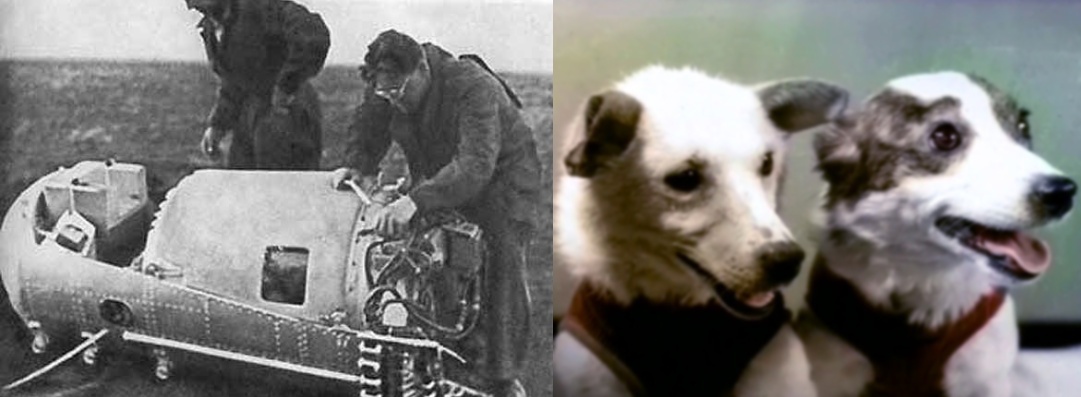
Braking in space
The first task to be solved is the determination of the time for issuing a braking impulse. The Earth rotates around its axis, and the landing site rotates with it. The satellite rotates in its orbit, the plane of which is usually inclined relative to the axis of rotation of the Earth:

If you draw a satellite’s line of motion over the Earth on the map, you will get sinusoids, which eventually shift to the left on the map due to the rotation of the Earth:
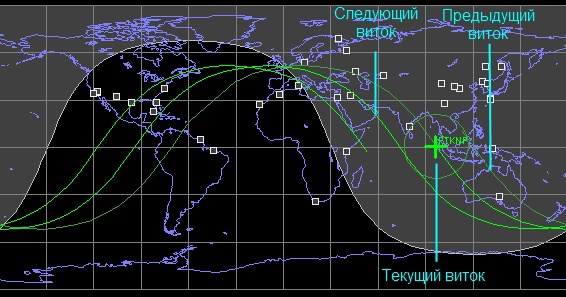
Therefore, if we want to land in the landing area, this can be done not at each turn. But, knowing the ship's orbit, it is possible to predict when the landing site will be in the plane of the orbit.
The second task is to give the required braking impulse. Each real spacecraft has a permissible range of entry angles. If the angle is too large, then the density of the atmosphere will increase too quickly, and this will cause unacceptable overload or unacceptable heat load on the thermal protection. If the angle is too small, the atmosphere will not be able to “capture” the device, and it will fly back into space.
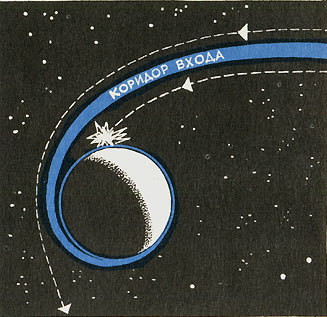
')
Braking in the atmosphere
The third task is to survive inhibition in the atmosphere. For this, the devices are equipped with special heat protection. Ablative thermal protection is made of multiple layers of asbestos-textolite, impregnated with a coating of phenol-formaldehyde resins. It slowly burns, like a book, in layers, losing the temperature brought from outside by the burned layer. Such heat protection is disposable, it has been used since the beginning of astronautics, it is widely used now. The second option is composite materials and ceramics, from which reusable tiles are made covering the apparatus. The Space Shuttle and Buran used this option.
The fourth task is descent control. Initially, the descent was uncontrollable. The Soviet vehicles were round, they automatically oriented themselves in the flow like a vanka-vstanka and descended along a ballistic trajectory. Such a scheme is very reliable; it is still used in the scientific and biological satellites Foton and Bion. American vehicles used shunting engines and spin to maintain flight mode heat shield forward. Ballistic descent has serious drawbacks - congestion reaches 9 g when returning from a circular orbit, 12 g when returning from the moon, and the landing area is measured in hundreds or even thousands of square kilometers. Therefore, the developers of space technology began to develop devices with controlled landing - Apollo and Soyuz. The idea realized in them is the same. Placing the center of mass outside the axis of symmetry leads to the fact that the device flies at a steady angle of attack, creating a lifting force:

This lifting force is spent on the following actions:
- Slow down the apparatus, which stretches the braking, reducing overload.
- Drop control, allowing you to land more accurately.
With controlled descent at the "Unions" and "Apollo" overload reaches 3-4 g, and the deviation from the aiming point is usually several kilometers.
Landing
The fifth task is a soft landing. In the US, all ships except shuttles boarded the water. The water is “softer” than the ground when landing at low speed, and the large US fleet allowed us to quickly and efficiently lift aboard vehicles. In the USSR, on the Vostok ships, the cosmonaut catapulted at a height of several kilometers, in order to, instead of hitting the ground in the apparatus, absorb the kicks. Sunrises and Soyuz used a parachute-jet system: a parachute gives a steady low rate of descent, and just before touching the ground, jet engines reduce it, ideally, to zero.
PTK NP
The Perspective Piloted Transport System (PPTS) currently being developed, also known as the Piloted Transport Ship of the New Generation (PTK NP), is a ship with a rather long and interesting history. And it is necessary to tell and explain why it is needed, and why it uses the selected technical solutions.
Why is it needed?
This is not an idle question. The fact is that the ship "Soyuz" was originally created for flights to the Moon and, theoretically, can cope with the tasks that are set before the PTK NP. Over the fifty years that it has been in operation, the Soyuz has gained a reputation as a space Gazel - not a very comfortable, tight, but durable and reliable ship. Why change it to something new? However, there are such reasons. Despite all its advantages, the Soyuz has shortcomings that cannot be fixed by modernization:
- Economy. Disposable and fully reusable ships were not very successful extremes. A partially reusable ship in which only consumable units such as a heat shield are replaced should be cheaper and easier to operate. "Union" can not be made partially-reusable - a blow to the ground when landing violates the guarantee for the strength of the hull. It is possible (and so it is done) to remove knots from a flying ship and to put on a new one, but, since this is not provided for by the design, it is not very effective.
- Large size of landing zones. Now, the landing zones of the Union have already begun to be perceived as large. The maneuvering capabilities during descent are limited by the design of the descent vehicle - a high “headlight” cannot reach large angles of attack. Exact landing is not compatible with the opening of parachutes at an altitude of 10 km - in a few minutes of descent the wind can carry the ship over a long distance.
- Ballistic descent. The ballistic descent mode requires the reservation of a separate landing area: the first area for a controlled landing, the second in case of a breakdown in the ballistic descent. An overload of 9 g will not please space travelers, and when returning from the moon, an overload of 12 g is already becoming hazardous to health. Worse, a disruption in a ballistic descent upon returning from the moon at the Soyuz means an emergency landing in the Indian Ocean, which is now no good at all.
- Tightness Union - quite a close ship. Of course, astronauts are not accustomed to overcome the burden and deprivation of space flight, but why not remove them, if possible? And if we are going to carry space tourists, then it is better to load them more, and provide them with acceptable conditions.
- The small weight of the returned load. The descent vehicle of the Soyuz can return only 50 kg of cargo together with the crew, which causes inconvenience.
- A small margin of characteristic speed. If we are going to fly to the Moon, then we want to have a larger, than now, reserve of the characteristic speed (delta-V). The Soviet lunar program was extremely, at the level of risk of flight safety, limited in fuel reserves due to the insufficient payload of the H-1 rocket, and a simple increase in the instrumental-aggregate compartment of the Soyuz is impossible without, in fact, creating a new ship.
- Media Restrictions. The Soyuz ship is firmly tied to the Soyuz launch vehicle, which is now withdrawing it without a reserve for increasing payload. Transplanting a ship to the "Proton", as was done in the 60s, is theoretically possible for the lunar program, but it is extremely irrational, because the "Proton" gradually leaves the stage because of its shortcomings.
Goodbye wings
One of the notable technical decisions that were made at the PTK NP was the abandonment of the wings (compare with the Clipper and MAKS ). PTK NP is a capsule, a bit similar to the American Apollo. The fact is that the wings are incompatible with versatility. They help to make an accurate landing, but this benefit is not comparable to the losses that will arise if you accelerate the mass of wings and aerodynamic surfaces that are useless in space to the Moon, the base at Lagrange, asteroids or Mars.
Special landing
The second notable technical solution was the landing system PTK NP. Initially, she thought completely reactive, because such a scheme gives the greatest accuracy of landing. However, a fully reactive landing raises safety issues, so the parachutes are back. In its current form, the landing system consists of the following steps:
- At a height of several kilometers, a heat shield is dropped (as in the Union).
- Three parachutes open at an altitude of 1.5 km. Since three domes are used, a spare parachute is not needed (the failure of one dome gives a permissible increase in the rate of descent).

- Disclosed landing shock absorbers.

- Immediately before touching the ground, a complex jet landing system is triggered. It fends off side drift by the wind (if any) to lower the capsule vertically and reduce the speed of descent to a soft touch.
- The ground contact energy is absorbed by the landing supports and shock absorbing crew seats (as a precautionary measure).
Such a landing pattern is expected to ensure a square hit of 5x5 km with a regular landing.
Development history
It all began, probably, with the idea of ACTS - a ship with the ESA to fly to the Moon, approximately in the middle of zero. It was originally planned, apparently, the modified "Union" with the upper stage "Frigate" and the joint Russian-European equipment:

By the end of zero, the idea of a joint ship with ESA died, the ship began to be developed as soon as the Russian, and instead of modifying the Soyuz, it was created from scratch. The descent vehicle with the influx of shunting engines on the side, characteristic of the end of the zero years, was:
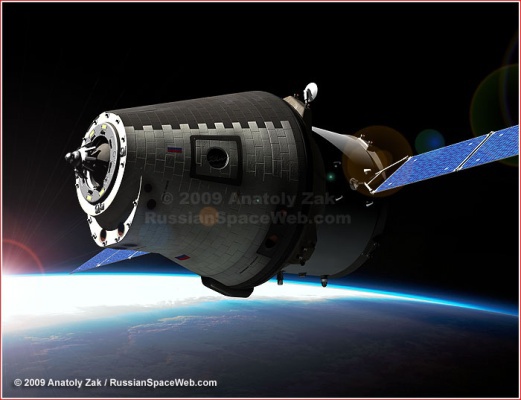
With the beginning of the tenth year, the influx disappeared:
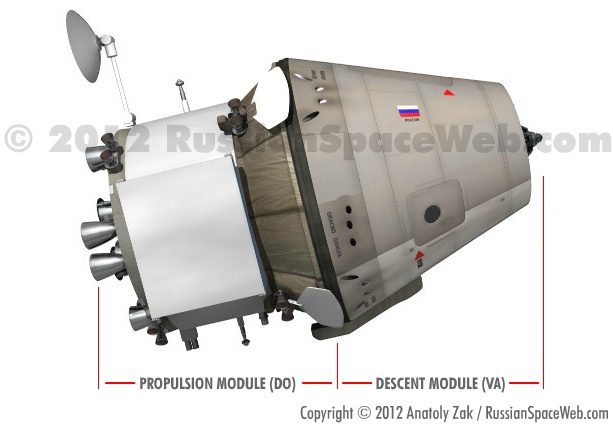
This model is implemented in Orbiter. It is already outdated and not very realistic (why 8 cruise engines?).
The most recent appearance of the ship in public - MAKS 2013:
Work is very actively carried out, Roscosmos regularly talks about them. Last video - the program "Astronautics", shown last Saturday:
News sources
You can track the progress of the PTC NP by:
- Profile topic on the Cosmonautics News forum
- TV Roscosmos
- The test cosmonaut Mark Serov's blog , who works at RSC Energia on the topic of the PTK NP.
Flight preparation
For this flight we need:
- Orbiter itself , if you have not downloaded it yet
- Addon PTK NP
- Addon Aerobrake MFD
Flight plan
This flight can be divided into the following stages:
- Combining the plane of the orbit with the landing site.
- Braking for de-orbiting.
- Controlled deceleration in the atmosphere.
- Landing.
Stage 1. Combining the plane of the orbit with the landing site
Download the script. I chose the flight saved in the last post, so it seemed to me more interesting, you can use your save or load the script PTK NP - Docked to ISS :
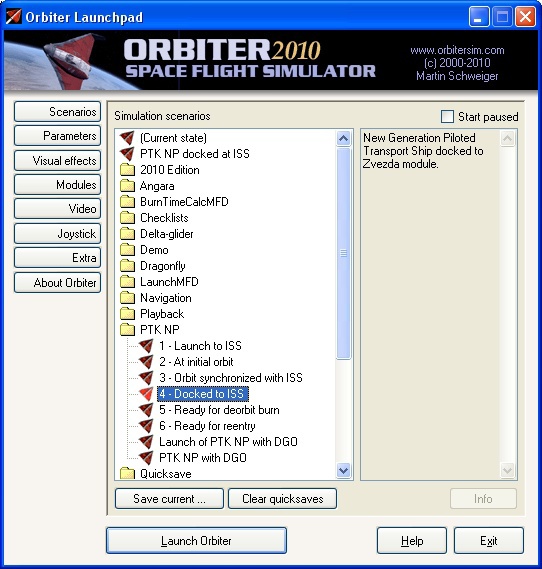
So, we docked to the ISS.

We want to return to the Vostochny space center, so in the MFD card we select it as a target ( right Shift - T , Spaceports - Vostochny ). Also, we will transfer the left MFD to Aerobrake mode ( left Shift - F1 , left Shift - E , target selection left Shift-T , type Vostochny in the appeared window). Accelerating time, we will wait until the next turn we fly over the "East". Uncoupling the ISS via Ctrl-D and give a small impulse to the divergence:

Goodbye, ISS!
Stage 2. Braking for de-orbiting
After the divergence from the ISS, we are waiting for 18,000 km to Vostochny, orienting the ship to braking stern ahead and giving impetus for de-orbiting at the moment when 17,000 km remains to Vostochny.

We brake until MFD Aerobrake shows a shortage of 1000 km:
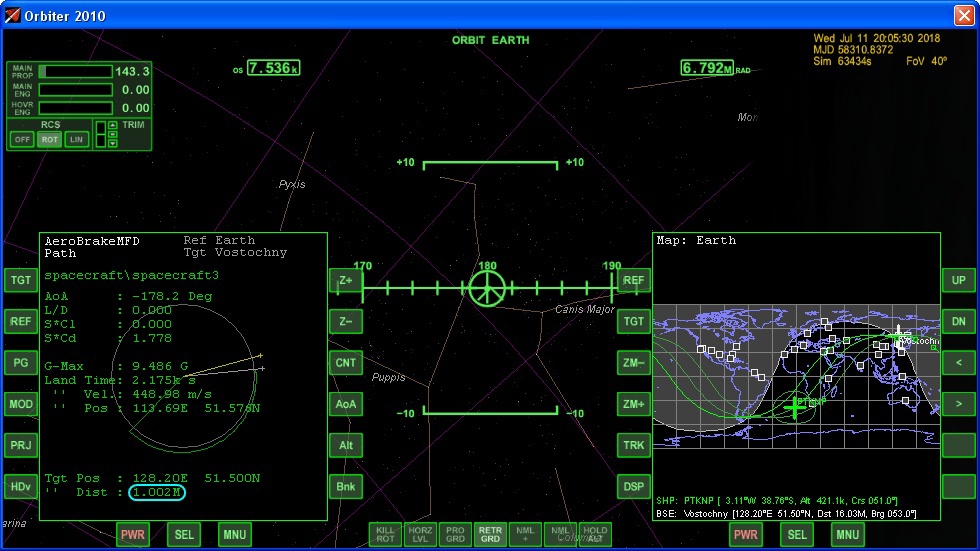
We need the undershoot for aerodynamic quality utilization.
Stage 3. Controlled atmospheric drag
Before entering the atmosphere, it is also necessary to separate the compartments. Orient the ship to a position opposite the orbital velocity vector (stern ahead) and with zero roll. There is a good automatic mode of maintaining the orientation "horizon level" - L :
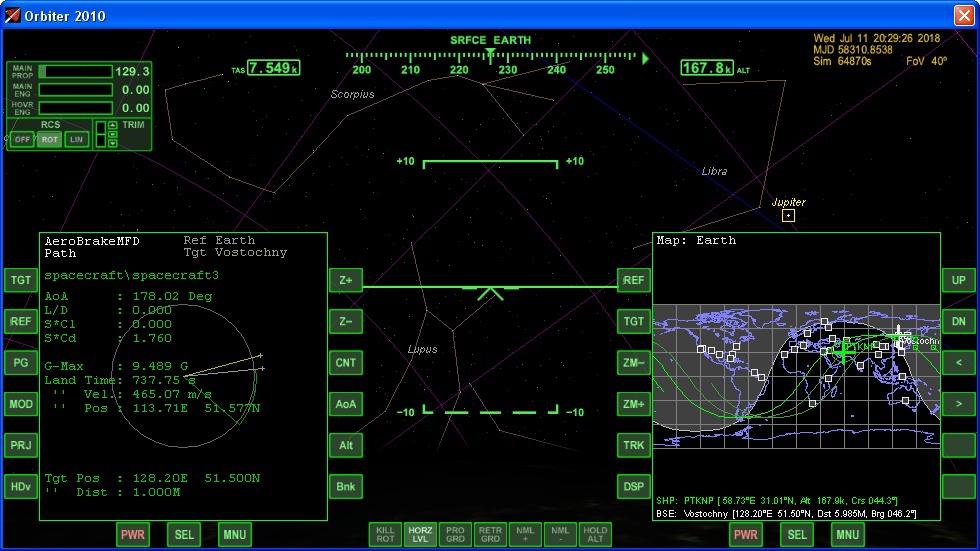
Let's wait for the height of 150 km and shoot off the cable-mast by pressing K , reset the instrument-aggregate compartment by pressing J. Unfortunately, after separating the compartments, the MFD parameters will be reset. We will again select “East” as the target for Aerobrake MFD. Pay attention to the change in the undershoot - the MFD, unfortunately, considers only real data, without a forecast. Pressing the PRJ and PG buttons will transfer it to map mode. Let's translate the right MFD into the mode of atmospheric flight ( right Shift - F1 , right Shift - S ). Result on the picture:
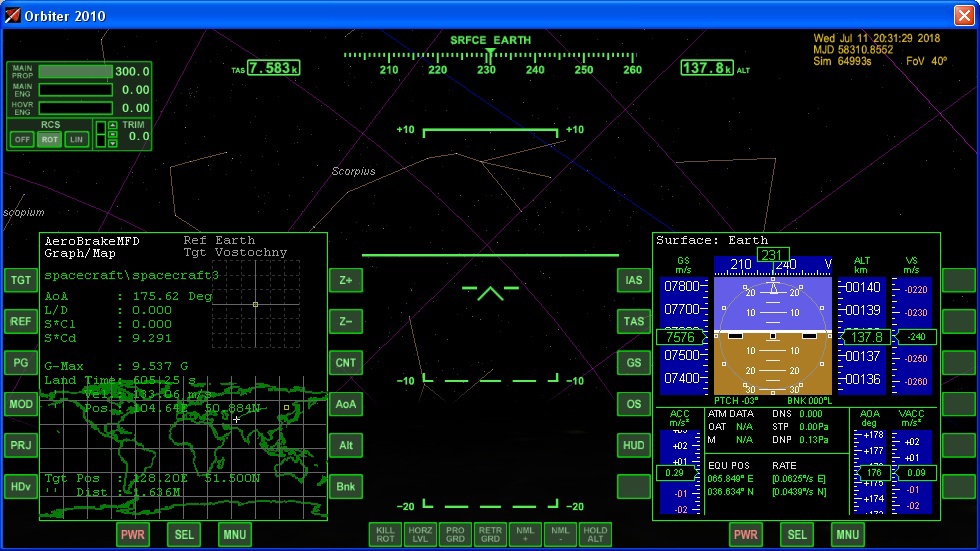
Our two methods of control will be trimmer and roll. The trimmer is set with the Ins and Del buttons of the block above the cursor keys and simulates the position of the center of mass:
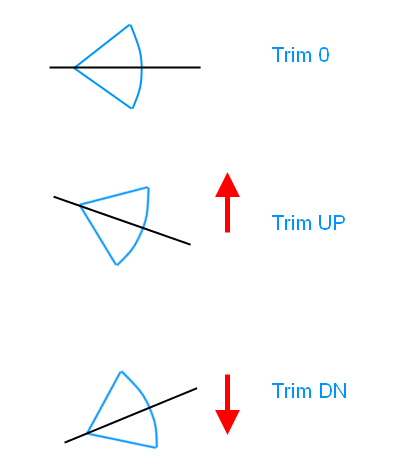
In reality, this angle is fixed, but here, fortunately, we can change it, this adds flexibility.
By changing the roll angle, we can create a lateral component of the lift force to shift to the north or south. If the device were more maneuverable, it would be possible to spend excess energy, moving "snake", but I did not succeed.
At an altitude of 130 km, where the first traces of the atmosphere appear, set the pitch angle to 10 degrees and set the trimmer to the maximum up.
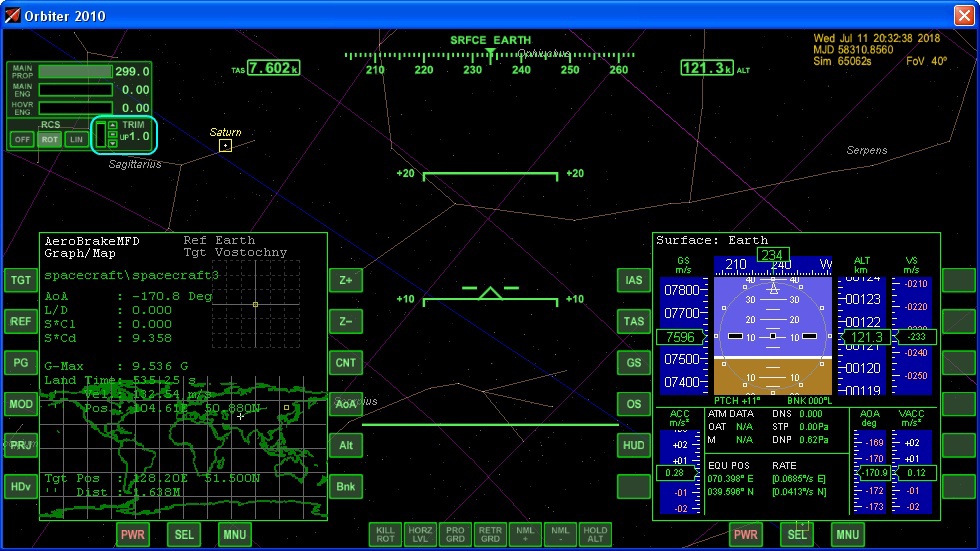
At 100 km it's time to turn on the theme music.
In the process of decreasing with the onset of exposure to the atmosphere, the capsule will settle at a pitch angle of about 12 degrees. Variations are possible, but do not allow a strong buildup, parry it with the KILLROT mode ( Num 5 ).
The height of 65 km, pay attention to the reduction of the undershoot on the left MFD and the indication of noticeable lift on the right MFD:

Height 61 km. The capsule has already lost one kilometer per second and goes into climb due to the lifting force:
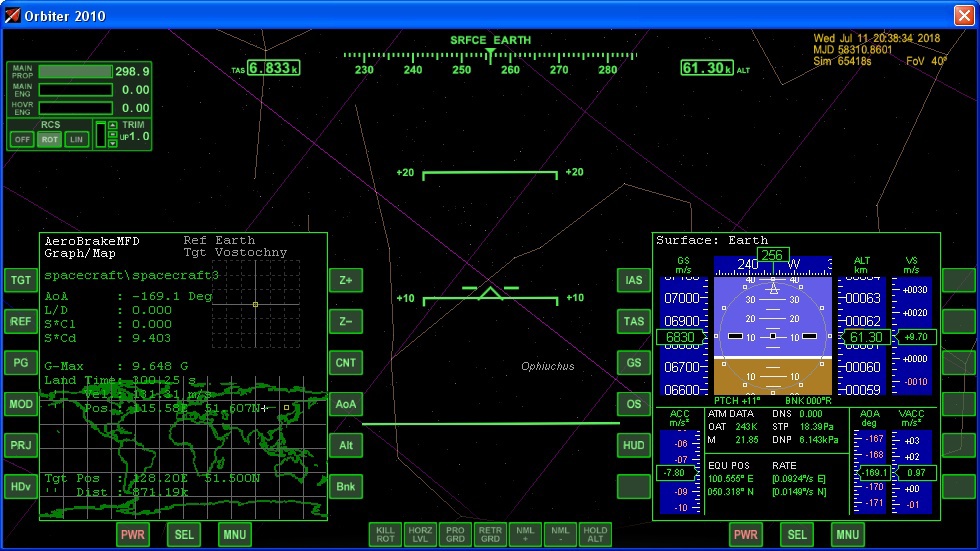
Height 50 km. A flight of our flight appears on the left MFD:

Judging by the track, we will go just south. In order to shift to the north, we need to tilt the ship to the right. In this case, the lifting force will receive a lateral component deflecting us to the north. It is necessary to keep a balance between maintaining the lifting force and lateral displacement in order not to sit down with an undershoot.
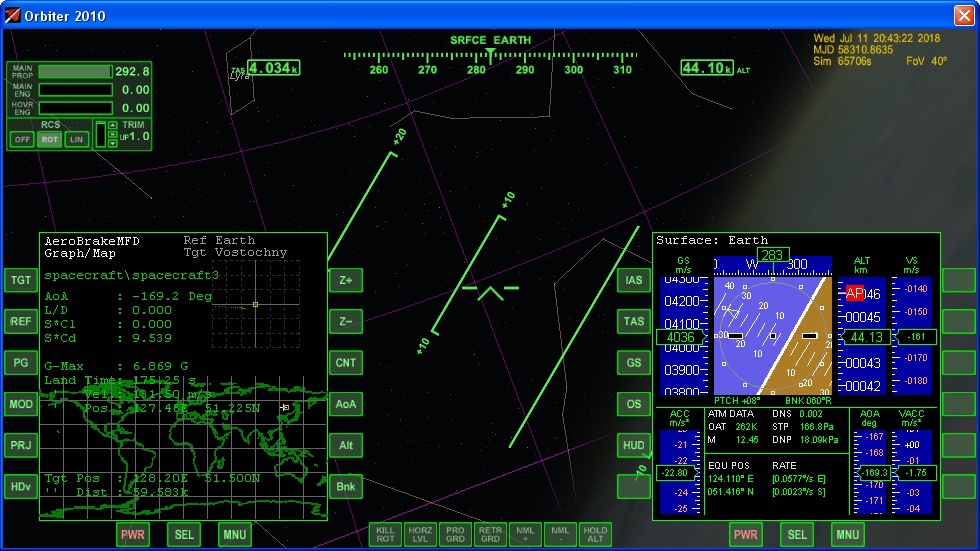
At an altitude of less than 40 km, we return the ship to a more vertical position - the speed drops, the lifting force falls. Pay attention to the overload - 3.3 G - quite comfortable, and it is already decreasing. This overload can also be experienced in public transport.

Below 15 km we reset the trimmer, it will not help us anymore. Error 12 km, sorry, more than I would like.

Landing
At an altitude of not less than 5 km we reset the hatch of the parachute compartment by pressing J. At a height of not less than 3 km, we launch the procedure for opening parachutes by pressing K. At an altitude of 1 km, we reset the heat shield by pressing J and unfold the landing supports by pressing G. We are going to land:

At a height of 30 m we turn on the brake motors (in the usual way - press Num + and fix the activation with the Ctrl key)
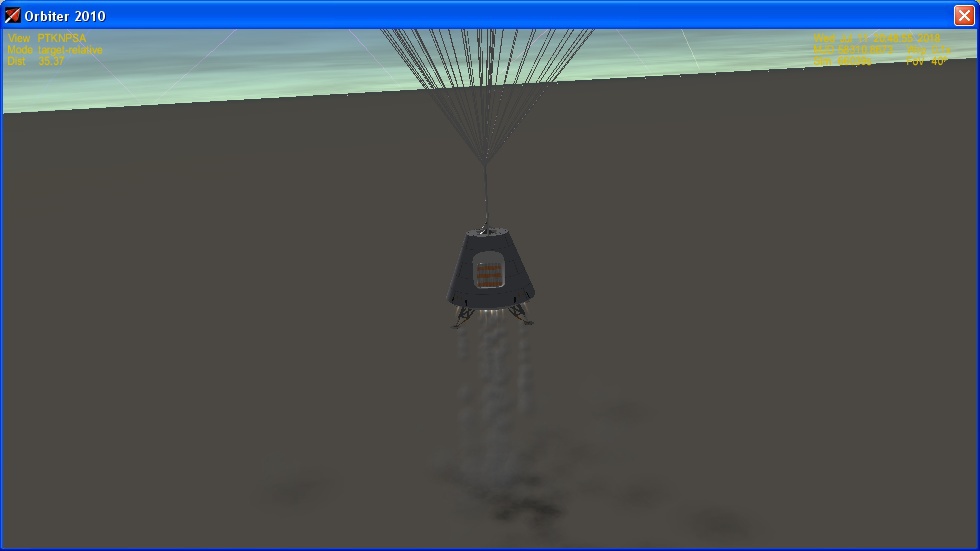
By touching the ground (if you have time), we turn off the engines. We fold the parachutes ( left Shift - Num 1 ) and open the hatch ( left Shift - Num 2 ). There is a landing!

Conclusion
The specificity of a controlled landing is that you have to act quickly and there is no way to correct the error. Therefore, good results will come with practice. My personal best is 550 meters from the aiming point. Successes in controlled landing!
Just in case, the Russian-language manual . For PTK NP and other add-ons there is usually documentation, it is located in the Doc or Add-on Docs folders.
For KDPV thanks to the site with pictures of Leonov and Sokolov .
Image source PTK NP - RussianSpaceWeb .
Source: https://habr.com/ru/post/217503/
All Articles